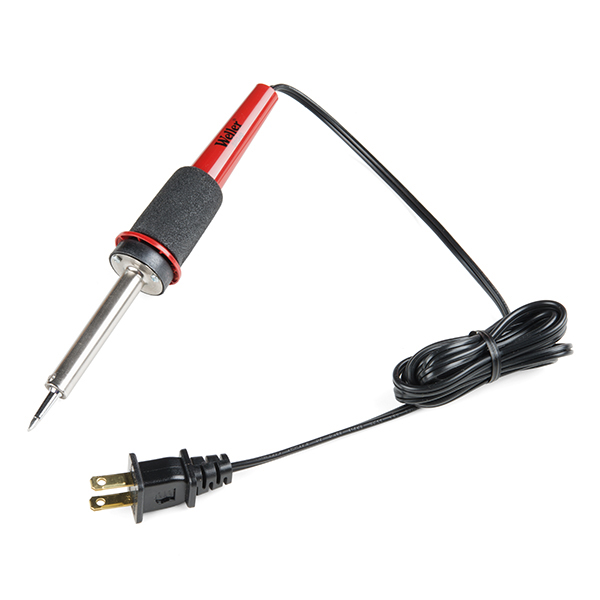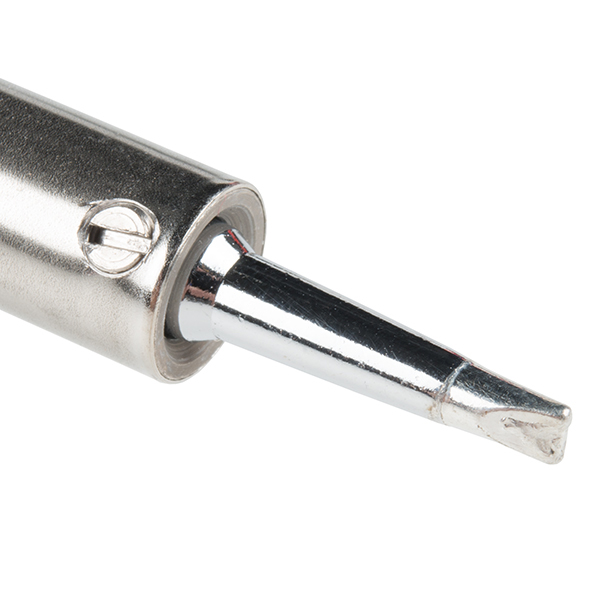Weller WLC100 Soldering Station
The WLC100 from Weller is a versatile 5 watt to 40 watt soldering station that is perfect for hobbyists, DIYers and students. The WLC100 operates at 120V and features a continuous dial to provide variable power control to the soldering station. The included 40 watt "pencil" soldering iron is lightweight with a cushioned foam grip and an interchangeable, iron-plated, copper ST3 tip. The soldering iron can even be detached for your on-the-go soldering needs!
In addition, the unit comes with a soldering station that includes a safety guard iron holder and a natural sponge tip cleaning pad. If you are looking for a good mid-range soldering iron without breaking the bank, the Weller WLC100 is an ideal soldering choice!
- Maximum Temperature: 900°F
- Wattage: 5W--40W
- North American 120VAC
- Soldering Station for Hobbyist and DIYer
- On/Off switch with "power-on" indicator light
- Variable power control built in to station
- Quality lightweight round pencil iron for rolling tip
- Cushioned foam grip with replaceable heating element
- Safety guard iron holder
- Natural sponge tip cleaning pad
- Includes ST3 tip
- [WLC100 Guide](https://cdn.sparkfun.com/datasheets/Tools/WLC100 Guide001.pdf)
- Soldering Tutorial
Weller WLC100 Soldering Station Product Help and Resources
How to Solder: Castellated Mounting Holes
May 12, 2015
Tutorial showing how to solder castellated holes (or castellations). This might come in handy if you need to solder a module or PCB to another PCB. These castellations are becoming popular with integrated WiFi and Bluetooth modules.
How to Solder: Through-Hole Soldering
September 19, 2013
This tutorial covers everything you need to know about through-hole soldering.
Core Skill: Soldering
This skill defines how difficult the soldering is on a particular product. It might be a couple simple solder joints, or require special reflow tools.
Skill Level: Noob - Some basic soldering is required, but it is limited to a just a few pins, basic through-hole soldering, and couple (if any) polarized components. A basic soldering iron is all you should need.
See all skill levels
Core Skill: DIY
Whether it's for assembling a kit, hacking an enclosure, or creating your own parts; the DIY skill is all about knowing how to use tools and the techniques associated with them.
Skill Level: Noob - Basic assembly is required. You may need to provide your own basic tools like a screwdriver, hammer or scissors. Power tools or custom parts are not required. Instructions will be included and easy to follow. Sewing may be required, but only with included patterns.
See all skill levels
Comments
Looking for answers to technical questions?
We welcome your comments and suggestions below. However, if you are looking for solutions to technical questions please see our Technical Assistance page.
Customer Reviews
3.5 out of 5
Based on 2 ratings:
1 of 1 found this helpful:
Uneven heat distribution
I’m not a huge fan of this solder iron mostly because of the seemingly incredibly uneven heat distribution in the tip. Even after being tinned and cleaned, the tip seems to be very temperamental which can be frustrating when soldering multiple parts. It’s possible it’s user error, but I haven’t had any issues with the soldering irons at work. ☹️
Great soldering station for the money
I was looking for a soldering station that provided the basic features: - Built-in stand - On-off switch - Temperature regulator
This station does all this very well. The temperature regulator has nice "drag" to it, feels well-built, not cheap. The on-off switch is easy to operate, not too tight. A minor thing perhaps, but I absolutely love the heat-shielded grip.
For soldering small components on a small (about 5-inch square) circuit board with fairly dense component layout, a temperature setting of 4 seems to work well.
Great buy for the money.




Wow they still make this? This was my second soldering iron (first was a 60W fixed power firestarter that literally glowed red hot if you left it plugged in too long), and I quickly learned that temperature controlled irons are the only way to go. To start it up, I'd set it to 5, then as it warmed up, had to lower to 4 and around 3 for good soldering, otherwise it would get too hot and oxidize the solder too quickly. I wouldn't recommend this even if you are on a budget, do yourself a favor and get a nice temp controlled Weller or Hakko, you'll thank yourself later.
I own one of these. Unless something has changed, the power control knob is continuous, not "five-position" as the above description claims.
You are absolutely right. Updated!
Worth mentioning - this iron is power controlled, not temperature controlled. Think of it like the control knob of a stove burner - you can control how much heat you put into it, but you can't tell it to go to a specified temperature and stay there.